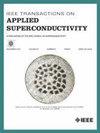Racetrack-Shaped HTS Coils With Metal-as-Insulation: Transient Behavior Model and Experimental Validation Status
IF 1.7
3区 物理与天体物理
Q3 ENGINEERING, ELECTRICAL & ELECTRONIC
引用次数: 0
Abstract
High Temperature Superconductors (HTS) offer significant potential for very high field application, thanks to their high current density. However, the high thermal stability make the protection of such magnets challenging. This is why CEA is exploring the use of specific No-insulation (NI) technology — and more precisely Metal-as-Insulation (MI) technology — to implement a protection layer within the design phase. The transient behavior of the REBCO combined with this NI or MI technology needs to be quantified at high magnetic fields to ensure the effectiveness of the protection. Following this goal, a dedicated Partial Element Equivalent Circuit (PEEC) model has been developed for several years at CEA and has been updated recently with the addition of racetrack shaped coils. Our PEEC model allows us to simulate multiples racetrack-shaped coils with different parameters such as power supply current, voltage limitation, local degradation, heaters, and external magnetic fields. To validate this model, we built coils samples. The dimensions of the samples were thoroughly chosen to allow meaningful comparison with the model. Preliminary tests have been performed in a liquid nitrogen bath (77 K) and in self-field configuration. Moreover, to validate the behavior of the coils when a local degradation is applied, it is required to control this defect accurately. Therefore, we also conducted an experimental study to control the size and level of degradation we apply on the tape. These data enable us to provide precise inputs for our numerical simulations.求助全文
约1分钟内获得全文
求助全文
来源期刊

IEEE Transactions on Applied Superconductivity
工程技术-工程:电子与电气
CiteScore
3.50
自引率
33.30%
发文量
650
审稿时长
2.3 months
期刊介绍:
IEEE Transactions on Applied Superconductivity (TAS) contains articles on the applications of superconductivity and other relevant technology. Electronic applications include analog and digital circuits employing thin films and active devices such as Josephson junctions. Large scale applications include magnets for power applications such as motors and generators, for magnetic resonance, for accelerators, and cable applications such as power transmission.
 求助内容:
求助内容: 应助结果提醒方式:
应助结果提醒方式:


